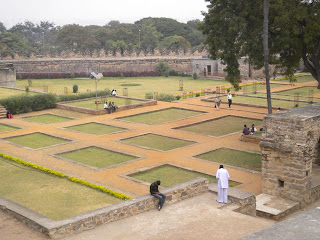We spent our first full day in Hyderabad sightseeing. Golconda Fort occupies the highest land in the Hyderabad area and was therefore the seat of power for several hundred years. We've become discriminating connoisseurs of fine forts over the past week, having seen the Red Fort in Delhi and the Red Fort in Agra (the Mughals were not good with names). Golconda is much larger and more intimidating than the other, so on the advice of our driver we hired a guide at the gate. His name was Javet, and he told us that god willing ("inshallah") he would take us up the 750 steps to the top, and inshallah, we would return down the other side. He recited the facts about Golconda like verses of a prayer, closing his eyes and bobbing his head as he spoke and counting on his dark, well-manicured fingers seven of this and seven of that (walls, pipes, kilometers--everything was measured in sevens). Besides the info he provided, Javet was helpful in one other important way: he posed us for pictures.


Before entering the harem complex, we noticed a pile of rocks, covered in saffron-colored paint, under a tree. Javet informed us with a casual hand flip that it was a snake hole. "He is a cobra, come out at 7:30 every night." And the orange paint? Another hand flip. "Is the Hindus..."
Midway through the harem tour, Javet asked for my camera. "You have big flash? Good. You stay here." He walked confidently into a dark tunnel, from which came a strange hissing sound. I assumed it was water. I was wrong.
Yes, those yellow spots are the eyes of bats. "Twenty, twenty-five thousand," according to Javet. Strange that where once the king lodged his 360 wives (one for each day of the year, plus five days vacation), you now find a harem of bats. I'm not sure what that means, metaphorically. I just think it's strange.
These guys were on their way up the 750 steps to the ice cream concession at the summit. Indians complain a lot about how cold it is in winter (a chilly 75 Fahrenheit today) between licks of ice cream.
After Golconda, we drove a few km down the road, through a particularly seedy neighborhood, to the Qutub Shahi Tombs. I was surprised by how cool this place was: a sprawling, parklike burial ground for the members of the dynasty who ruled Hyderabad in the sixteenth and seventeenth centuries. The government of Andhra Pradesh charges a few rupees for admission, but I suspect the fee is waived for locals. Families picnicked among the five-story-high, four-hundred-year-old marble mausoleums, waving hello and sending their children to ask "please what is your country?" (The answer to this question, by the way, is not "the United States" or "America" but "USA," pronounced with an accent so that it sounds like this: "you ess ee" Before we got here, I had heard that Indians tend to understand you better if you speak English with an Indian accent. I always thought that was an arrogant idea, but it seems true that people here appreciate it if you meet them halfway, accent-wise)
We lived in Williamsburg, Virginia, for two years while Jessica was in graduate school and were serenaded ad nauseum about the importance of historical preservation. The idea of a historical theme park, or a "living history museum" like Colonial Williamsburg, would be unfathomable in India, mostly because there are just too many historically relevant sites. Everywhere you look you see history--the spires of a three-hundred-year old Hindu temple behind the parking lot of a call center. Or this place. To my eye there is more architectural history in one of these tombs than in Jamestown and Williamsburg combined. And the picnicking is excellent as well.









